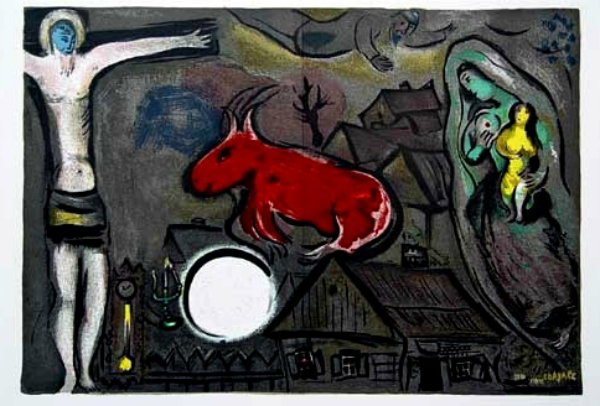Tel : (+33) 4 94 63 18 08
9am - 6pm from Monday to Sunday
All products Marc Chagall • Products of the topic Lithographs
Lithograph Chagall : Mystical crucifixion
REF : MC-L-02
In stock
Only 1 in stock
Unavailable
99,00 €
One of the 2 lithographs published in 1950 (2nd edition) in the famous "Derriere Le Miroir" (DLM)
Signed and dated (1950)in the plate on lower right. Inscriptions at the back of the work
Engraver : Charles SORLIER
The 2 lithographs are officially referenced with n° 49 in the catalogue raisonné "Chagall, the book of the books" of Charles SORLIER
This lithograph bears the normal central fold for original lithographs published on double pages
Dimensions : 56 x 38 cm (15" x 22")
Discover the artist's categories
Marc Chagall
Additional cultural and artistic information about the artist
* * *
Main works
The "Violinists" (blue or green), The Life, Above the City, and The Bride.
Artistic movements
Judaica and, in its early stages, Neo-primitivism
Inspiration, influence
The life of the Shteti (Jewish village in Eastern Europe) is one of his favorite subjects. Pictorially, he will never belong to any school, but will take (or even borrow) elements that can feed his painting here and there (from the Fauvists, the Constructivists, the Cubists, or the Grand classics).
His contemporaries
Marc Chagall was not the type to socialize with other painters, so immersed in his own world, so true to himself, to his loved ones, and to his childhood dreams. His impact on his contemporaries is difficult to quantify... On the general public, it is even more impressive!
To keep in mind
Chagall is first and foremost a unique universe, a genius tightrope walker on the delicate line of the Jewish diaspora in the heart of the 20th century! From Russian Pogroms to the heights of Saint-Paul de Vence, Chagall experienced travel, the loss of his works, the loss of the one he loved madly (Bella), and yet he always knew how to start over, put the blank canvas back on the easel, and reinvent his world.
To go further
It is necessary to discover the stained glass windows that he created (those of the Reims Cathedral or those of the Chagall Museum in Nice). It is also necessary to go and admire the ceiling of the Opera Garnier and understand that Chagall is a narrative painter, a man who narrated what we all experience in life, happiness and unhappiness, births and deaths, love and loss of love... And that he portrayed all of this in colors like no one else, in a luminous and universal allegory.
Biography of Marc Chagall
Marc Chagall
Marc Chagall was born in Belarus in 1887.
The discovery of the work of Van Gogh and Cézanne would be the trigger for his approach to painting. Arriving in Paris in 1910, he met with Apollinaire, Cendrars, but also Modigliani and Delaunay.
The First World War brought him back to his native country, where he was, for a time, fascinated by the Russian Revolution.
Returning to Western Europe, Chagall illustrated "Dead Souls" and "The Fables of La Fontaine", before tackling his masterpiece in illustration: "The Bible".
At the same time, the theme of the crucifixion invaded his work, while the rise of anti-Semitism in Europe led him to move to the United States.
Back in France after the end of the war, he embarked on the creation of monumental works linked to architecture, such as the cathedral of Metz, the new parliament of Jerusalem, the Maeght Foundation, or the ceiling of the Paris Opera.
His lithographic production is also impressive, with fifteen to twenty lithographs per year from 1952 onwards.
He passed away on March 28, 1985, in Saint-Paul de Vence, two years before the opening of the retrospective that the Pushkin Museum in Moscow finally dedicated to him.
(c) Natacha PELLETIER for PASSION ESTAMPES









